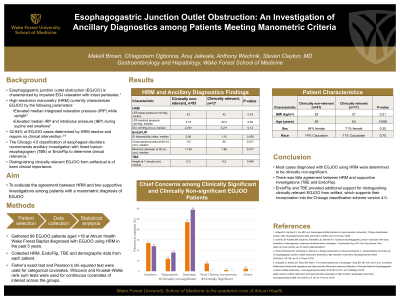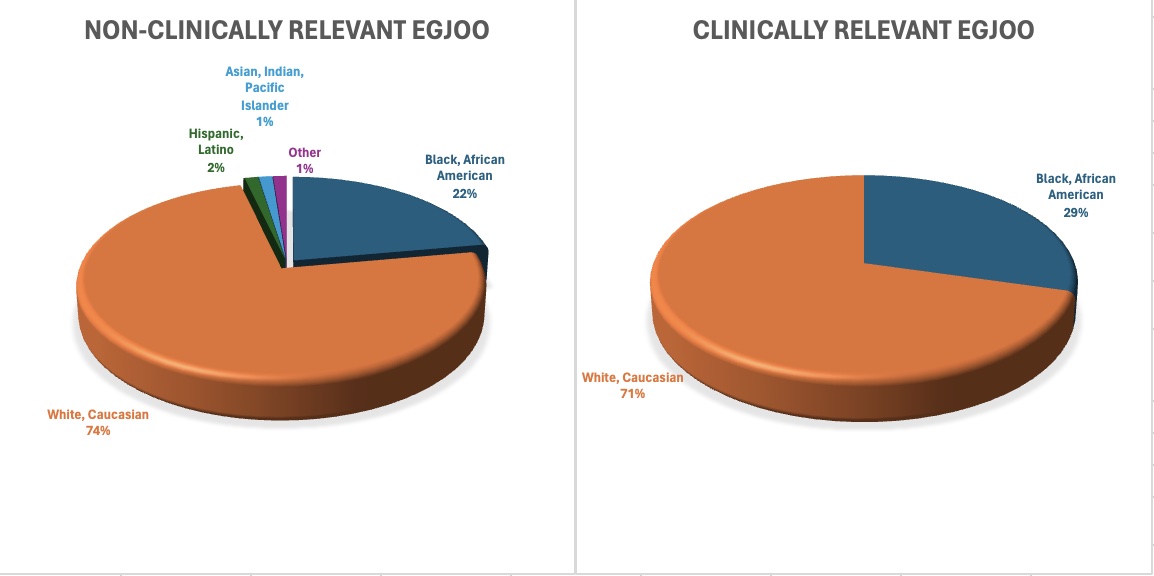Tuesday Poster Session
Category: Esophagus
P3897 - Esophagogastric Junction Outflow Obstruction: An Investigation of Ancillary Diagnostics Among Patients Meeting Manometric Criteria
Tuesday, October 29, 2024
10:30 AM - 4:00 PM ET
Location: Exhibit Hall E

Has Audio
- AJ
Anuj Jailwala, BSc
Wake Forest University School of Medicine
Winston-Salem, NC
Presenting Author(s)
Anthony Wachnik, BSc, Anuj Jailwala, BSc, Steven Clayton, MD, Chiagoziem Ogbonna, MD
Wake Forest University School of Medicine, Winston-Salem, NC
Introduction: Most high-resolution manometry (HRM) diagnoses of Esophagogastric Outflow Obstruction (EGJOO) are not clinically relevant. Distinguishing clinically relevant EGJOO from artifactual is of keen clinical importance. The aim of this study was to evaluate the agreement between results of HRM and the two supportive investigations when evaluating patients with the manometric diagnosis of EGJOO.
Methods: Our study includes all patients age >18 who have had HRM studies done at our institution over the last 5 years. A chart review of the electronic medical records was performed on each of these patients and data from HRM, TBE, and EndoFLIP were entered into a deidentified database. Where appropriate, Fisher’s exact test and Pearson’s chi-squared test were used for categorical covariates, whereas the Wilcoxon and Kruskal-Wallis rank sum tests were used for continuous covariates of interest across the groups.
Results: 1506 patients have undergone HRM at our hospital, and 543 (36%) have met manometric criteria for EGJOO. Out of the 130 patients that have been reviewed up to this point, 98 were followed up with supportive investigations, with only 17 (17.3%) found to be clinically relevant. When comparing the two groups, there was no difference in race (p= 0.75), sex (p=0.30), or chief concern (p=0.89). The most common chief concerns were symptoms of dysphagia and heartburn. Table 1 demonstrates that the LES basal and residual pressures did not differ between the groups. The TBE column height at 1 min was significantly higher for clinically relevant EGJOO (6.20 cm vs 0.0 cm, p=0.04). EndoFLIP balloon pressure and minimum diameter at both 60 mL (p=0.002) and 70 mL (p=0.044) were significantly lower for clinically relevant EGJOO.
Discussion: This retrospective cohort study shows that, while HRM identified a large cohort of patients with EGJOO, most cases diagnosed were determined to be clinically irrelevant. Although heartburn and dysphagia were common chief concerns, supportive investigations did not always support the final diagnosis of EGJOO. TBE and EndoFLIP provided additional support for distinguishing clinically relevant EGJOO from artifact, which supports their incorporation into the Chicago classification scheme version 4.0.

Note: The table for this abstract can be viewed in the ePoster Gallery section of the ACG 2024 ePoster Site or in The American Journal of Gastroenterology's abstract supplement issue, both of which will be available starting October 27, 2024.
Disclosures:
Anthony Wachnik, BSc, Anuj Jailwala, BSc, Steven Clayton, MD, Chiagoziem Ogbonna, MD. P3897 - Esophagogastric Junction Outflow Obstruction: An Investigation of Ancillary Diagnostics Among Patients Meeting Manometric Criteria, ACG 2024 Annual Scientific Meeting Abstracts. Philadelphia, PA: American College of Gastroenterology.
Wake Forest University School of Medicine, Winston-Salem, NC
Introduction: Most high-resolution manometry (HRM) diagnoses of Esophagogastric Outflow Obstruction (EGJOO) are not clinically relevant. Distinguishing clinically relevant EGJOO from artifactual is of keen clinical importance. The aim of this study was to evaluate the agreement between results of HRM and the two supportive investigations when evaluating patients with the manometric diagnosis of EGJOO.
Methods: Our study includes all patients age >18 who have had HRM studies done at our institution over the last 5 years. A chart review of the electronic medical records was performed on each of these patients and data from HRM, TBE, and EndoFLIP were entered into a deidentified database. Where appropriate, Fisher’s exact test and Pearson’s chi-squared test were used for categorical covariates, whereas the Wilcoxon and Kruskal-Wallis rank sum tests were used for continuous covariates of interest across the groups.
Results: 1506 patients have undergone HRM at our hospital, and 543 (36%) have met manometric criteria for EGJOO. Out of the 130 patients that have been reviewed up to this point, 98 were followed up with supportive investigations, with only 17 (17.3%) found to be clinically relevant. When comparing the two groups, there was no difference in race (p= 0.75), sex (p=0.30), or chief concern (p=0.89). The most common chief concerns were symptoms of dysphagia and heartburn. Table 1 demonstrates that the LES basal and residual pressures did not differ between the groups. The TBE column height at 1 min was significantly higher for clinically relevant EGJOO (6.20 cm vs 0.0 cm, p=0.04). EndoFLIP balloon pressure and minimum diameter at both 60 mL (p=0.002) and 70 mL (p=0.044) were significantly lower for clinically relevant EGJOO.
Discussion: This retrospective cohort study shows that, while HRM identified a large cohort of patients with EGJOO, most cases diagnosed were determined to be clinically irrelevant. Although heartburn and dysphagia were common chief concerns, supportive investigations did not always support the final diagnosis of EGJOO. TBE and EndoFLIP provided additional support for distinguishing clinically relevant EGJOO from artifact, which supports their incorporation into the Chicago classification scheme version 4.0.

Figure: Figure 1. Racial breakdown among non-clinically (left) and clinically relevant (right) EGJOO patients
Note: The table for this abstract can be viewed in the ePoster Gallery section of the ACG 2024 ePoster Site or in The American Journal of Gastroenterology's abstract supplement issue, both of which will be available starting October 27, 2024.
Disclosures:
Anthony Wachnik indicated no relevant financial relationships.
Anuj Jailwala indicated no relevant financial relationships.
Steven Clayton indicated no relevant financial relationships.
Chiagoziem Ogbonna indicated no relevant financial relationships.
Anthony Wachnik, BSc, Anuj Jailwala, BSc, Steven Clayton, MD, Chiagoziem Ogbonna, MD. P3897 - Esophagogastric Junction Outflow Obstruction: An Investigation of Ancillary Diagnostics Among Patients Meeting Manometric Criteria, ACG 2024 Annual Scientific Meeting Abstracts. Philadelphia, PA: American College of Gastroenterology.
